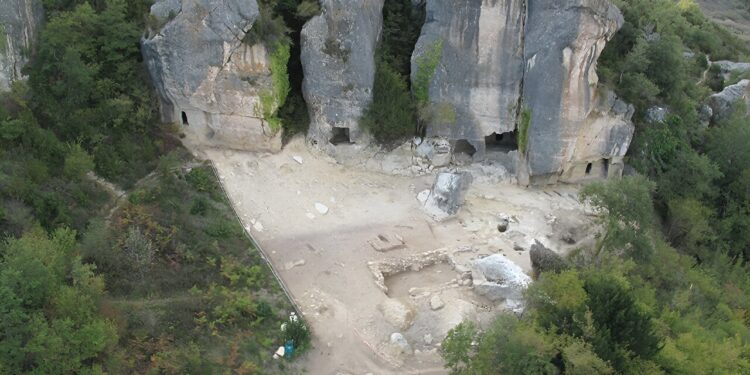Aerial view of the excavated area in the medieval settlement of Las Gobas (Condado de Treviño, Spain). / GPAC (Grupo de investigación en Patrimonio Construido) University of the Basque Country. Credit: GPAC (Grupo de investigation en Patrimonio Construido) University of the Basque Country
An archaeogenetic study sheds new light on the isolated medieval community of Las Gobas in northern Spain. In addition to isolation and endogamy, the researchers also identified the smallpox virus, which could offer a new explanation for how smallpox entered the Iberian Peninsula.
Swedish and Spanish researchers have conducted an in-depth archaeogenetic study of a community that lived on the border between the northern Christian kingdoms and Al-Andalus in the early medieval period. This dynamic era, particularly in the Iberian Peninsula, was marked by religious competition, power struggles and significant human mobility, factors that shaped the foundations of modern Europe.
The study, published in the journal Scientific progressfocused on Las Gobas, a rural site in the province of Burgos, northern Spain, near the village of Laño. The community existed from the mid-6th to the 11th century and is known for its church and cave dwellings. The site also yields evidence of violence, probably from sword blows, found on some of the people buried there. Forty-one burials were excavated, and 39 of them were subjected to archaeogenetic analysis.
The interdisciplinary research, led by Ricardo Rodríguez Varela of the Centre for Paleogenetics (CPG) in Stockholm, integrated genetic, archaeological and historical data to reveal the presence of an endogamous community in the northern Iberian Peninsula that remained relatively isolated despite centuries of turbulent regional history.
Aerial photography of the graves. Credit: Lourdes Herrasti
“Our results indicate that this community remained relatively isolated for at least five centuries,” Rodríguez Varela said. Although Las Gobas is located just north of the regions under Islamic rule, “we found relatively low levels of North African and Middle Eastern ancestry compared to other medieval individuals in the Iberian Peninsula, and we did not observe a significant increase in these ancestries after the Islamic conquest of the Iberian Peninsula,” he concluded.
Zoé Pochon, also from the CPG, highlighted the discovery of several little-studied pathogens in the human remains from Las Gobas. “For example, Erysipelothrix rhusiopathiae, a bacterium that causes skin diseases through contamination of open wounds, often infects humans through domestic animals, suggesting that animal husbandry was important for this community.”
She also identified the variola virus, the agent that causes smallpox, in an individual from one of the most recent burials. This specific strain is similar to those found in Scandinavia, Germany and Russia, highlighting the pan-European presence of smallpox in the Middle Ages.
Skulls showing traces of violence. Photo credit: Lourdes Herrasti
Anders Götherström, lead author of the study and also based at the CPG, highlighted the comprehensive nature of their research: “It is astonishing how much information we were able to gather about this group of people through our archaeogenetic investigation. An endogamous group, familiar with violence, appears to have settled in Las Gobas during the 6th or 7th century. In the 10th century, smallpox appears to have affected Las Gobas, probably spreading across Europe rather than through Islamic routes, as was previously theorized for how smallpox entered the Iberian Peninsula.”
This study provides new insights into the complex social, genetic, and health dynamics of a long-isolated community in early medieval Spain.
More information:
Ricardo Rodríguez-Varela et al., Five Centuries of Consanguinity, Isolation, Health and Conflict in Las Gobas: A Medieval Northern Iberian Necropolis, Scientific progress (2024). DOI: 10.1126/sciadv.adp8625. www.science.org/doi/10.1126/sciadv.adp8625
Provided by Stockholm University
Quote:Study reveals isolation, endogamy, and pathogens in early medieval Spanish community (2024, August 28) retrieved August 28, 2024 from
This document is subject to copyright. Apart from any fair dealing for the purpose of private study or research, no part may be reproduced without written permission. The content is provided for informational purposes only.



